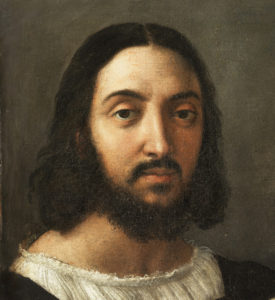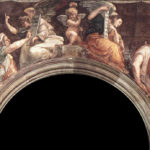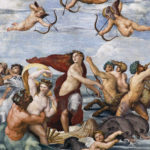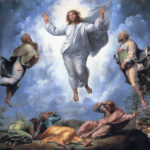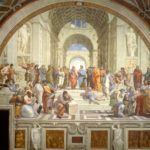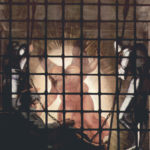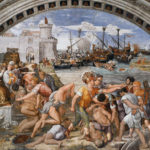Raphael and His Art
Raffaello Sanzio (born April 6, 1483, in Urbino and died April 6, 1520, in Rome), more commonly known as Raphael, is one of the most iconic painters and architects of the Italian Renaissance. Rome was the city where he reached the peak of his fame. His work inspired entire generations, giving rise to the Mannerist school.
His style is characterized by a subtle harmony between drawing and color, with neither overshadowing the other. The “grazia,” or grace, and the “dolce maniera,” or gentle manner, that animate his compositions often contrast with the “terribilità,” or stylistic power, of Michelangelo. It was from his master, Perugino, that Raphael drew inspiration for the softness of his lines, while borrowing the modeling of figures from Michelangelo and the sfumato technique, which softens contours, from Leonardo da Vinci.
Raphael’s Journey and Pictorial Works in Rome
Born in Urbino where he grew up, at the age of 20, he made his first trip to Rome in 1503, during which he visited the remains of antiquity and witnessed the election of Julius II, who would become his patron. From 1499 to 1504, he lived in Città di Castello, Perugia, and the surrounding areas of Siena. Between 1504 and 1508, he settled in Florence, where he gained significant recognition. He then returned to Rome in 1508 to join a team of artists from across Italy, including Michelangelo, engaged in a vast project to renovate the Vatican and the city, initiated by Julius II, who called upon the greatest talents in the country.
He remained in Rome until his death, passing away prematurely at the age of 37 on April 6, 1520. In accordance with his wishes, he was buried in the Pantheon in Rome, where his tomb remains today.
Shortly after his arrival, Raphael was tasked with painting the Vatican apartments, creating masterpieces such as the Room of the Signature, the Room of Heliodorus, and the Room of the Fire in the Borgo, works that marked the beginning of the classicist period and foreshadowed Mannerism. Later, the banker Agostino Chigi entrusted him with the decoration of the Villa Farnesina (designed by Baldassare Peruzzi) between 1511 and 1518. There, he created the Triumph of Galatea, the fresco of the Loggia of Cupid and Psyche, and designed the decoration of a room illustrating the Stories of Alexander and Roxane (later executed by Sodoma). It was also during this period that Raphael painted the portrait of his beloved Margherita Luti, immortalized in the famous painting La Fornarina, preserved in Rome at the Palazzo Barberini.
During his Roman sojourn, he also innovated in the art of portraiture, including representations of the Virgin and Child in altarpieces. From 1518, he worked on the decoration of the Vatican Loggias, initiated by Bramante, producing remarkable works such as the Loggetta of Cardinal Bibbiena and the Loggia of Raphael. He also painted the Prophet Isaiah in the Basilica of Sant’Agostino, as well as the fresco of the Sibyls and Angels at Santa Maria della Pace.
Today, several Roman galleries—notably the Vatican Pinacoteca, the Doria Pamphilj Gallery, and the Borghese Gallery—preserve many of his paintings (see below).
Raphael in Roman Architecture
In parallel with his pictorial masterpieces, Raphael left a lasting mark on architecture. He was appointed head of the St. Peter’s Basilica project in 1514, after Bramante’s death, reinstating the idea of the original basilica’s longitudinal body, integrating it into the cross designed by Bramante.
He also designed the Palazzo Jacopo da Brescia and the Palazzo Alberini, and conceived the Chigi Chapel in Santa Maria del Popolo. He designed the Palazzo Vidoni Caffarelli, likely executed by his student Lorenzo Lotti. In 1520, he designed the Palazzo Branconio dell’Aquila, his final project, which was later demolished to make way for Bernini’s Colonnade in St. Peter’s Square.
Raphael’s Works in Rome’s Churches
The Prophet Isaiah, 1511-1512, fresco, 250×155 cm, Basilica of Sant’Agostino
- Sibyls and Angels, 1514, fresco cycle, Santa Maria della Pace Church
- Drawings for the mosaics of the Chigi Chapel, 1516, Basilica of Santa Maria del Popolo
Raphael in Rome’s Palaces and Monuments
- Villa Farnesina
- The Triumph of Galatea, 1511, fresco
- Loggia of Psyche, 1517, fresco cycle
Triumph of Galatea
Palazzo Apostolico (Apostolic Palace of the Vatican)
- Frescoes of the Stufetta of Cardinal Bibbiena, 1516
- Apostles, c. 1517, lost
Raphael’s Works in Rome’s Museums
- Borghese Gallery
- Portrait of a Man, 1503-1504
- Lady with a Unicorn, 1505-1506
- Baglioni Altarpiece, 1507, polyptych, in several parts
Borghese Deposition, 184×176 cm
- Doria Pamphilj Gallery
- Portrait of Andrea Navagero and Agostino Beazzano, 1516
- National Gallery of Ancient Art at Palazzo Barberini
- La Fornarina, 1518-1519
- Vatican Pinacoteca (Pinacoteca Vaticana)
- Oddi Altarpiece, 1502-1503, 267×163 cm.
Annunciation / Adoration of the Magi / Presentation at the Temple
- Oddi Altarpiece, 1502-1503, 267×163 cm.
- Baglioni Altarpiece, 1507, polyptych, in several parts
Speranza / Carità / Fede, 16×44 cm - The Madonna of Foligno, 1511-1512, 320×194 cm
Raphael’s Tapestries, 1515-1516, intended for the Sistine Chapel, seven of the ten cartoons preserved are in London
Life of Peter: The Miraculous Draught of Fishes / Christ Giving the Keys of Paradise to Peter / The Healing of the Lame Man / The Death of Ananias
Life of Paul: The Stoning of Saint Stephen (no cartoon) / The Conversion of Saint Paul (no cartoon) / The Conversion of the Proconsul / The Sacrifice at Lystra / Saint Paul in Prison (no cartoon) / Saint Paul Preaching at Athens- Transfiguration, 1518-1520, 405×278 cm
- Monteluce Coronation, 1524-1525 (posthumous), 354×230 cm
- Baglioni Altarpiece, 1507, polyptych, in several parts
- Vatican Museums (Città del Vaticano, Musei Vaticani)
Room of the Signature, 1508-1511, fresco cycle
- Ceiling 1508: Primo Moto / Judgment of Solomon / Adam and Eve / Apollo and Marsyas / Theology / Justice / Philosophy / Poetry
- The Disputation of the Holy Sacrament, 1509, base 770 cm
- The School of Athens, 1509-1511, base 770 cm
- Parnassus, 1510-1511, base 670 cm
- The Cardinal and Theological Virtues, 1511, base 660 cm
- Room of Heliodorus, 1511-1514, fresco cycle
- Heliodorus Driven from the Temple, 1511-1512, base 750 cm
- The Mass at Bolsena, 1512, base 660 cm
- The Liberation of Saint Peter, 1513-1514, base 660 cm
- The Meeting of Leo I and Attila, 1514, base 750 cm
- Room of the Fire in the Borgo, 1514-1517, fresco cycle
- The Fire in the Borgo, 1514, base 670 cm
- Battle of Ostia, 1514-1515, base 770 cm
- Coronation of Charlemagne, 1516-1517, base 770 cm
- Oath of Leo III, 1517, base 670 cm
Raphael’s Loggia, 1518-1519, fresco cycle
- Loggia of Cardinal Bibbiena, 1519, fresco cycle
- Room of Constantine, 1520-1524 (posthumous), fresco cycle
- The Vision of the Cross
- Battle of the Milvian Bridge
- Baptism of Constantine
- The Donation of Rome
Raphael’s Architecture in Rome
- Church of Sant’Eligio degli Orefici (from 1509), facade redone in the 17th century
- Chigi Chapel (1513-1514) in the Basilica of Santa Maria del Popolo
- St. Peter’s Basilica (1514-1520)
- Raphael’s Loggia (1514-1519), Apostolic Palace, Vatican City
- Palazzo Vidoni Caffarelli (1515-1536)
- Palazzo Jacopo da Brescia (1515-1519), destroyed, then rebuilt
- Palazzo Alberini (1515-1519)
- Stables of Villa Farnesina (c. 1516), destroyed
- Villa Madama (from 1518)
- Palazzo Branconio dell’Aquila (c. 1519), destroyed
Raphael Itinerary in Rome: Map
If you see this after your page is loaded completely, leafletJS files are missing.









